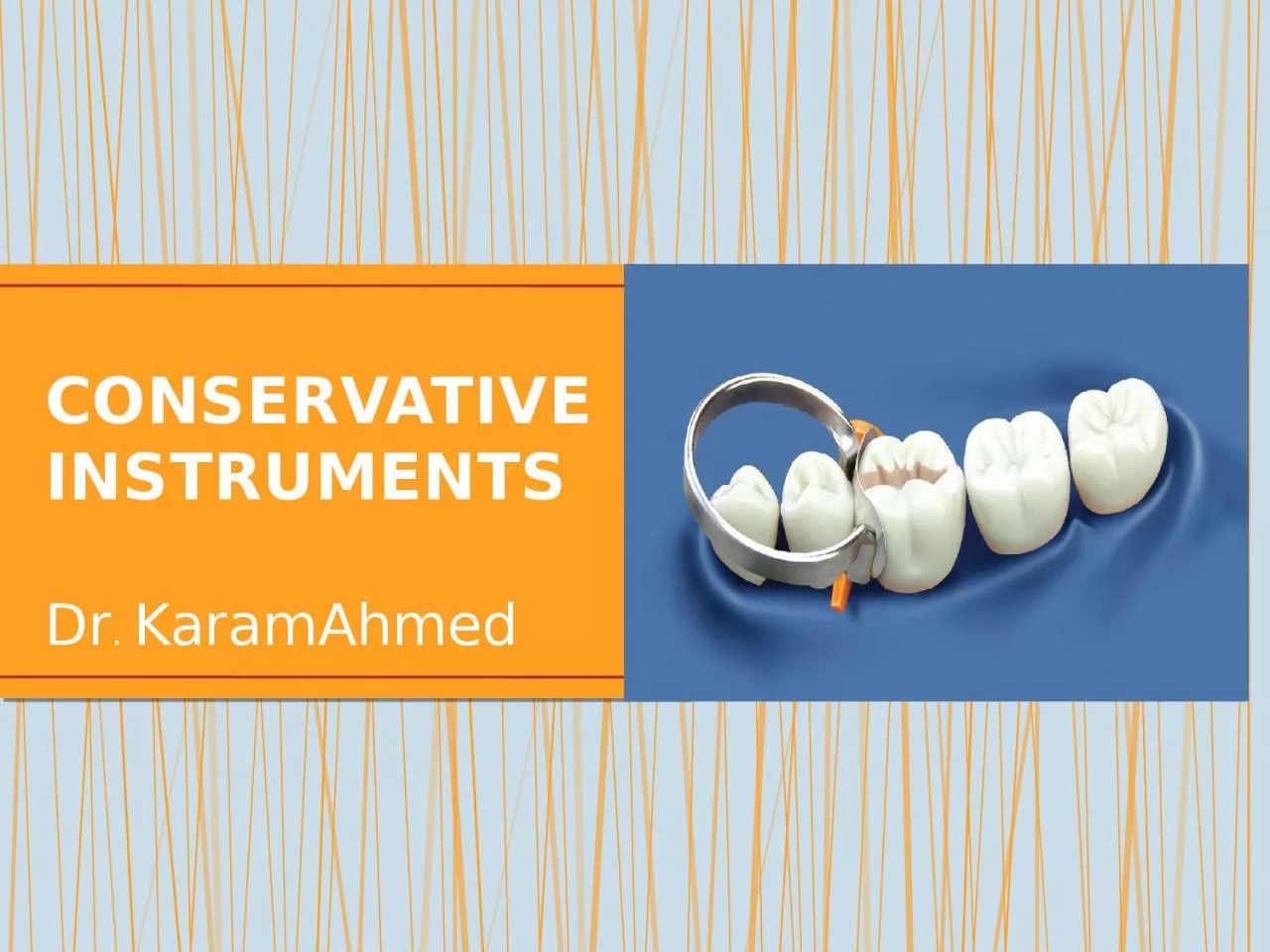

Dr KaramAhmed Operative Dentistry Conservative Dentistry Its the art and science of diagnosis treatment and prognosis of defects of teeth Such treatment should result in Goals ID: 930974
Download Presentation The PPT/PDF document "CONSERVATIVE INSTRUMENTS" is the property of its rightful owner. Permission is granted to download and print the materials on this web site for personal, non-commercial use only, and to display it on your personal computer provided you do not modify the materials and that you retain all copyright notices contained in the materials. By downloading content from our website, you accept the terms of this agreement.
Slide1
CONSERVATIVE INSTRUMENTS
Dr
.
KaramAhmed
Slide2Operative Dentistry
Conservative Dentistry
It’s the art and science of
diagnosis,
treatment and prognosis of defects of teeth. Such treatment should result in:
Goals
Restoration of proper tooth form.
Function.
Esthetic.
Maintain physiological integrity and harmonious relation with surrounding tissues.
Slide3History
Previously was a just a practice not based on scientific knowledge.
Louis Pasteur (France) Role of MO in disease.
G.V Black
(USA, 19
th
)
related the clinical practice to scientific bases.
Slide4Indications
Indications are numerous, but can be categorized into the following primary needs
:
Caries
.
Malformed teeth.
Discolored teeth.
Fractured teeth.
Replacement or repair of previous restorations.
Slide5Considerations
Infection control
.
Examine oral and systemic health of pt not only the affected tooth.
Oral manifestation of other diseases
.
Understanding of restorative material properties.
Understanding of oral environment to which the restoration placed.Understanding of biological bases and function of the various tooth component and supporting structures.Knowledge of correct dental anatomy.
Effects of operative procedures on the treatments of other disciplines.
Treatment plane.
Slide6CLASSIFICATIONS..
Slide7Slide8Instrument Nomenclature
Function:
e.g. condensers, carvers, cutting inst. ……. etc.
Manner of use:
hand condenser, mechanical condenser …
Design of working end
:
spoon excavator, sickle scaler.
Angulations of the shank:
mon-angle, bin-angle, triple…
Slide9General classification of hand instruments
1. diagnostic instruments.2. isolation of operating field instruments.
3. manipulation of restorations instruments.
4. carver instruments.
5. finishing and polishing instruments. 6. cutting instruments.
Slide101. Diagnostic instruments
Used for inspection and exploration of both teeth and surrounding soft tissue ex: mirror,probe and tweezers…etc
Slide112. isolation of operatiing field instruments.
Manuals: by absorbents e.g: cotton rolls or pellets and rubber dam
Slide12Mechanical: by low and high suction
Slide133. manipulation of restorations instruments.
Condensing : used in packing and condensation e.g: amalgam condenser and carrier
Slide14Pluggers
Pluggers are also known as amalgam condensers. They are used to achieve a well condensed filling by compressing the filling material into the cavity and applying pressure.
Slide15Plastic instruments: instruments used in manipulation of
restorative materials
made from
metal and used with composite
Slide16Matrices:
instruments used with class2 cavity, aiming to support the material to prevent it during it’s packing from escaping outside the cavity .
ivory and tofflemire:
Slide17Palodent composite matrix :
Slide18bitine
rings:
Slide19Composite tight ring:
Slide20Non cutting instruments
Dycal applicator
: to place calcium hydroxide or glass ionomer in cavity preparation
Slide21A
dappen glass (also called Dappen Dish) is a small, dense glass or ceramic vessel which has each end ground or hollowed out to provide a bowl for mixing substances. Generally these
dishes
have ten equal walls (decagon) with a large bowl on one side and a smaller bowl ground out on the other.
Slide22Slide23Cement Spatula
. This non-rusting, stainless steel cement spatula is excellently suited for mixing
cement
, filling materials and small quantities of impression materials. The double-ended mixing
spatula consists of one flat, straight functionalend and one flat, tapered functional end.
Slide24Slide25Glass slap: for mixing.
Slide26Ash 49: for restoration.
Slide274.Carving instruments
Used to establish the anatomical form of restoration surface, the most common: Hollenbeck carver and ball burnisher.
Slide28Burnisher
Slide295.Finishing and polishing instruments:
Hand e.g.finishingstrips (removes overhang and flashes of restorations)
Slide30Rotary e.g.
finishing burs, finishing stones, sand paper disc, sof-lex discs, black bristle brush, and rubber cups (are used for polishing of amalgam restoration).
Slide31Finishing stone:
Slide32sand paper
disc:
Slide33sof-lex discs:
Slide34black bristle
brush:
Slide35rubber
cups:
Slide366.Cutting instruments
Used for cutting and finishing of tooth structure and restorativesHand and rotary-Hand cutting instruments
: 2 families
Chisels (push & pull)
hatchet (right & left)
Slide37Chisels
Straight - bevels the cavosurface margin and used in 3, 4 and 5 classifications of cavities on the maxillary.
Wedelstaedt - only used in the anterior for classes 3, 4 and 5 as well.
Bin Angle - this is held in a pen grasp and used for class 2 maxillary only.
Slide38Straight chisel:
used for cutting enamel and no need for right and left
Bin-angle and Wedelstaedt chisels:
cutting edge perpendicular to long axis of handle. used for cutting enamel.
Slide39Ordinary Hatchet excavator
:
Primarily used on anterior teeth for preparing retentive areas and sharpen internal line angles for direct
gold restorations.
Hoe excavator
:
planing walls and forming line angles in class III
and IV for direct gold restorations. Angle former: sharpen internal line angles and preparing retentive features for gold restorationsSpoon
excavator: removal of caries, usually bin angled or triple angled to facilitate accessibility.
Slide40Ordinary , hoe and angle former:
Slide41Spoon excavators: different angles..
Slide42Cleoid-discoid:
used for caving unset amalgam and burnishing inlay/onlay margins
Cleoid
DISCOID
Slide43Knives:
finishing knives, amalgam knives, gold knives. All used for trimming the excess filling materials at cavity margins.
Files
: different size and shape also used for trimming the excess of filling material particularly at gingival margins.
Slide44-Rotary cutting instruments
Operative burs:
Flat fissure, pear-shaped, football, round, tapered, flame, chamfer, bevel, end cut, bud bur, steel, inverted cone, diamond, brown stone, and green-stone
Slide45Fissure bur
Slide46pear-shaped
Slide47Football
Slide48Round
Slide49Tapered
Slide50Flame
Slide51Chamfer
Slide52Bevel
Slide53End cut
Slide54bud
bur
Slide55inverted
cone
Slide56brown
stone
Slide57green-stone
Slide58THANK YOU